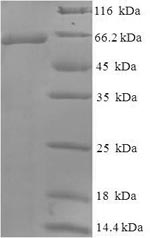Introducing our Recombinant Human WT1 protein, expertly crafted to support your transcription research endeavors. This full-length Wilms tumor protein (WT33) is expressed in an E. coli system, encompassing the 1-449aa region to ensure optimal functionality in your experiments.
Equipped with an N-terminal 6xHis-SUMO tag, this protein facilitates streamlined purification and detection processes. Our Recombinant Human WT1 protein exhibits a purity greater than 90% as determined by SDS-PAGE, and is available in both liquid and lyophilized powder forms to cater to your specific research needs. Rely on our precision-engineered WT1 protein to deliver consistent, high-quality results for your transcription studies.






